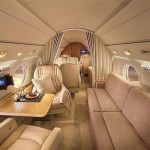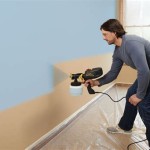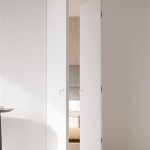Choosing The Right Interior Door Knobs With Backplates
Interior door knobs, often considered functional necessities, contribute significantly to the overall aesthetic and feel of a home. When selecting these essential hardware components, the choice extends beyond simply finding a knob that turns. Integrating backplates into the door knob design adds another layer of both style and practicality. A thoughtful approach to choosing interior door knobs with backplates can subtly yet powerfully enhance the interior design narrative of any space.
The process of selection involves considering several factors, including the existing architectural style, the desired level of formality, the degree of durability required, and the specific function of the door. Ultimately, the right choice will offer a harmonious blend of form and function, contributing to the overall comfort and appeal of the home.
Understanding the Function and Purpose of Backplates
Backplates, also referred to as escutcheons, serve both functional and decorative purposes. Functionally, they protect the door surface around the knob from scratches and wear caused by repeated handling. This is particularly important for doors made of softer materials or those located in high-traffic areas. The backplate effectively distributes the force of turning the knob, mitigating potential damage to the door itself.
Decoratively, backplates offer an opportunity to enhance the style and character of the door. They come in a wide variety of shapes, sizes, and finishes, allowing homeowners to coordinate the door hardware with the overall design scheme of the room. A carefully chosen backplate can complement the door's paneling, color, and other architectural details, creating a cohesive and visually appealing effect. Furthermore, they can conceal existing imperfections or damage around the doorknob opening, providing a clean and polished appearance.
Moreover, backplates can improve the perceived quality of the door and the knob. A well-designed backplate adds a sense of substance and sophistication, particularly when paired with a high-quality knob. This can be especially important in homes where attention to detail is valued.
Matching Style and Aesthetics: Integrating Door Knobs and Backplates with Interior Design
One of the primary considerations when selecting interior door knobs with backplates is to ensure they coordinate with the existing interior design. This requires an understanding of the prevailing style within the home, whether it's traditional, modern, contemporary, or a more eclectic mix. The door knob and backplate should complement the architectural features, the color palette, and the furniture styles present in each room.
For traditional homes, ornate backplates with intricate detailing, such as floral motifs or classical designs, are often a suitable choice. Knobs in materials like antique brass or oil-rubbed bronze can further enhance the traditional aesthetic. These finishes evoke a sense of history and craftsmanship, adding warmth and character to the space. The shape of the backplate can also play a role; rectangular or oval backplates with decorative edges are common in traditional settings.
In contrast, modern and contemporary homes often benefit from simpler, more minimalist designs. Backplates with clean lines and geometric shapes are well-suited to these styles. Finishes like polished chrome, brushed nickel, or matte black provide a sleek and sophisticated look. The focus is on functionality and understated elegance, rather than ornate detailing.
For transitional homes that blend elements of traditional and modern design, a more versatile approach is needed. Backplates with a simple, yet refined shape can work well in these spaces. Mixing metals, such as combining a brushed brass knob with a polished chrome backplate, can add visual interest and create a unique, personalized look. The key is to strike a balance between classic and contemporary elements.
Beyond architectural styles, also consider the existing hardware fixtures throughout the home. Lighting fixtures, cabinet hardware, and even plumbing fixtures can influence the selection of door knobs and backplates. Consistency in finish and style can create a sense of harmony and cohesion throughout the interior. If the bathroom has brushed nickel faucets, for example, consider using brushed nickel door knobs and backplates to maintain a unified look.
Material and Finish: Durability and Visual Appeal
The choice of material and finish significantly impacts both the durability and visual appeal of interior door knobs with backplates. Different materials offer varying degrees of resistance to wear and tear, while different finishes provide a range of aesthetic options to complement the interior design.
Common materials used for door knobs and backplates include brass, bronze, stainless steel, and zinc. Brass is a classic choice known for its durability and resistance to corrosion. It can be polished to a high shine or aged to create a more antique look. Bronze is another durable option that develops a rich patina over time, adding character and depth. Stainless steel is particularly resistant to rust and corrosion, making it a good choice for bathrooms or other areas prone to moisture. Zinc is a more affordable option that can be plated with different finishes to achieve a desired look.
Finishes play a crucial role in the overall aesthetic. Polished brass and polished chrome offer a bright and reflective surface, while brushed nickel and satin chrome provide a softer, more muted look. Oil-rubbed bronze and antique brass create a vintage feel, while matte black offers a contemporary and sophisticated contrast.
The selection of finish should consider the frequency of use and the potential for wear and tear. High-traffic areas may benefit from finishes that are resistant to fingerprints and scratches, such as brushed nickel or satin chrome. In contrast, decorative finishes like polished brass may require more frequent cleaning and maintenance to retain their luster.
Furthermore, the finish should complement the color palette and other hardware fixtures in the room. Lighter finishes, like polished chrome or brushed nickel, can brighten up a space, while darker finishes, like oil-rubbed bronze or matte black, can add depth and contrast. Consider the overall ambiance you wish to create and select a finish that aligns with that vision.
Practical Considerations: Size, Shape, and Door Thickness
Beyond the aesthetic considerations, several practical factors also influence the selection of interior door knobs with backplates. These include the size and shape of the knob and backplate, as well as the thickness of the door itself. Ensuring the door knob and backplate are appropriately sized and fitted to the door is crucial for both functionality and comfort.
The size of the door knob should be proportionate to the size of the door. A small door knob on a large door may appear insignificant, while an oversized knob on a small door may look overwhelming. Similarly, the size of the backplate should be in proportion to the knob. A large backplate paired with a small knob may create an unbalanced look, while a small backplate paired with a large knob may not provide adequate protection for the door surface.
The shape of the knob and backplate should also be considered. Round knobs are a classic and versatile choice that works well in a variety of settings. Lever handles are another popular option, particularly for individuals with limited mobility. Square or rectangular knobs and backplates offer a more modern and contemporary look. The shape of the backplate can further enhance the style of the knob, with options ranging from simple rectangular shapes to more ornate and decorative designs.
Door thickness is a critical factor to consider. Most door knobs and backplates are designed to fit standard door thicknesses, typically 1 3/8 inches or 1 3/4 inches. However, older homes or custom-made doors may have different thicknesses. It is essential to measure the door thickness before purchasing door knobs and backplates to ensure a proper fit. If the door is thicker or thinner than standard, you may need to order special hardware with longer or shorter spindles and screws.
Furthermore, consider the bore hole size of the door. This is the diameter of the hole drilled in the door to accommodate the door knob and latch mechanism. Standard bore hole sizes are typically 2 1/8 inches for the knob and 1 inch for the latch. Ensure that the door knob and backplate are compatible with the existing bore hole size. If the bore hole is too small, you may need to enlarge it, while if it is too large, you may need to use a larger backplate to conceal the opening.
Accessibility and Ergonomics
Accessibility and ergonomics are important factors to consider when selecting interior door knobs, especially for homes with elderly residents, individuals with disabilities, or young children. The design of the door knob and backplate should promote ease of use and minimize the risk of injury.
Lever handles are often a preferred choice for individuals with limited mobility or arthritis. They require less force to operate than traditional round knobs, making them easier to grasp and turn. The elongated design of the lever handle allows users to open the door with their hand, elbow, or forearm, reducing the need for fine motor skills. Lever handles are also compliant with the Americans with Disabilities Act (ADA), which sets standards for accessibility in public spaces.
For round knobs, consider those with a larger diameter and a comfortable grip. Knobs with a smooth surface can be difficult to grasp, particularly for individuals with weak hands. Knobs with a textured surface provide a better grip and reduce the risk of slipping.
The height of the door knob is also an important consideration. Standard door knob height is typically 34 to 38 inches from the floor. However, for individuals in wheelchairs, a lower height may be more accessible. Consider the needs of all occupants when determining the optimal door knob height.
The force required to operate the door knob should also be taken into account. Stiff or difficult-to-turn knobs can be challenging for individuals with limited strength or dexterity. Ensure that the door knob mechanism is smooth and easy to operate. Regular lubrication can help to maintain the smooth operation of the door knob over time.
In addition to the door knob itself, the backplate can also contribute to accessibility. A larger backplate provides a wider surface to grip, making it easier to open and close the door. The backplate can also help to protect the door surface from scratches and wear, reducing the need for repairs or replacements.

Door Knobs On Backplate Rose

Expert Guide To Choosing Interior Door Handles And Knobs

How To Choose An Interior Door Set

Choosing Door Hardware For A Farmhouse Newlywoodwards

Blair Knob With Tabor Backplate Interior Door Set Rejuvenation

A Guide To Updating Your Doors And Hardware Jenna Sue Design

Adding Character To Your Home Using Interior Door Knobs

A Guide To Updating Your Doors And Hardware Jenna Sue Design

How To Choose The Right Door Handle For Your House

Adding Historic Door Knobs Old Yankee Farmhouse
Related Posts








